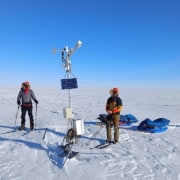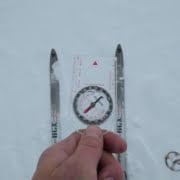7 Charging devices & batteries during winter expeditions
Charging batteries in winter. A breeze.
At the end of the day, the tents look beautiful. On a frozen lake just off the edge of the forest. It is windless. The openings face each other. A beautiful picture.
When you go outside for a moment after dinner you stare upward. It is cloudless. The Milky Way can be seen beautifully in all its glory. And then you see it in the corner of your eye. Yes. The Northern Lights. Green dancing light on the horizon which slowly takes possession of the entire sky. A truly phenomenal spectacle ensues. What a picture. The Northern Lights with the dark forests below and the tents contrasting lightly against the forest edge. You grab your camera to take the picture of a lifetime. But then, battery dead.

Northern lights over the Torneälven in Swedish Lapland
Winter trips and batteries. They have a true love-hate relationship. Many things require electricity. But that cold huh? This cold that is not really cooperating.
In this article, I share how I deal with this during expeditions.
On an expedition, you leave a lot behind. You take the minimum amount of stuff. Still, you can’t escape bringing equipment that uses power. Satellite phone, GPS and your camera to name a few. They must be charged during the trip. If you get that right then you’ll never have to sit with a dead battery again.
What electronic equipment goes with it?
During my crossing of Greenland, I carry a whole arsenal of equipment that runs on electricity. A satellite phone for contact with base camp and home front. An Iridium Go to send photos with for the blog. A camera to take the pictures with. A smartphone for editing photos and listening to music. A Garmin Inreach GPS tracker to automatically transmit location to base camp. A handheld GPS to know my exact location. A PLB (Personal Locator Beakon) Emergency Beacon. And finally a VHF radio for communication with rescue services and the helicopter pilot.

Commnication equipment for an expedition
The power supply.
To power everything, the Dutch brand Xtorm helps me. They are providing the solar panel and two powerbanks for the crossing. The charging cables also come from them. These are reinforced with kevlar and thus more or less unbreakable. I carried two mini-USB and one USB-C charging cable. Greenland is relatively low latitude. And the sun is right here for the solar panel to work on.
Priorities in charging
Because there are many devices shy of power, I have prioritized this.
In this prioritization, I considered safety first and pleasure later.
Prio 1: The Iridium Satellite Phone.
I use this one for daily contact with base camp. At that time, I can also pass on if one of the other devices has failed. If I don’t contact them, the base camp will call in emergency services. So it is important to contact them according to an agreed protocol. And for this, the satellite phone must be charged.
I have two batteries with me. Should 1 battery fail. Then I have a backup.

Iridium 9555 Satellite Phone
Prio 2: Garmin Inreach tracker.
This is the second way for base camp to see if we are still moving. If I don’t call the satellite phone then they are watching the progress on the Inreach. If it still goes in the right direction, then we follow the protocol and everything is probably ok. Inreach also updates the position on the website. Nice for the home front to keep track of where we are. The Inreach also has an emergency button that works much the same as the emergency beacon. And finally, the Inreach allows you to send messages. So a valuable additional means of communication.

Garmin inReach Explorer+ with a message to base camp
Prio 3: The Garmin GPSmap62s GPS.
Still useful to finally walk in the right direction and reach the final location. For this, the GPS is indispensable.

Garmin GPSmap62s GPS
Prio 4: The smartphone.
Nice to listen to music during the trip. Not essential, but fun. Also useful if the phone works for sending photos and short blog posts. But again. Fun, not extremely necessary.
Prio 5: The Panasonic camera.
To be brief. You can do without. Anyway. After a wonderful trip in the snow, it’s kind of nice to have pictures. So the battery does get charged. Almost last.

Panasonic Lumix LX 100 camera with protective case
Prio 6: The Iridium Go.
This is a kind of Wi-Fi satellite transmitter. This allows me to send the photos to base camp. This is a low priority and so it is hung last on steam.

Sending photos with the Iridium Go and a Smartphone
No prio 1: The PLB Emergency Beacon.
This contains internal batteries. So that’s not charging. The emergency beacon comes on only when there is a real emergency. Then I press the emergency button and with that I alert the rescue services. I always wear the PLB on the man. In other words, in my coat pocket.

Rescueme PLB1 Emergency Beacon
No prio 2: The VHF radio.
I only need it when I’m picked up and it doesn’t turn on in between. So that battery doesn’t drain during the trip.
Charging all equipment
First, I make sure everything is fully charged before I leave. A good start is half the battle. My Garmin GPSmap62s runs on two AA batteries. I brought lithium batteries from Energizer. These work best in the cold conditions in Greenland. I take 4 extra batteries with me and am sparing in the moments when the GPS comes on. But recharging is not necessary.
Also, the PLB does not need to be charged. Also saves again.
Using the solar panel for charging
For the rest, I work as follows. During the day shift, there is a solar panel on my sled. I use a foldable solar panel from Xtorm. I have 1 with me. Two power banks can be connected to that solar panel with a USB cable. These powerbanks, a rugged outdoor one from Xtorm, are in the sled. There is a small bag on the solar panel, though. But I think a power bank in the sled is safer. After all, it cannot fall out. The solar panel itself is attached to my sled with small carabiners.
So while moving, the powerbanks charge slowly but surely. This works even when it is cloudy. Said it less often.

Xtorm solar panel on the sled
Camp routine for charging
When we set up camp at the end of the day I first put the satellite phone on a power bank. I bought a special cable that goes from USB (From the power bank) to a round plug. (Satellite phone connection)
To the other power bank goes my Garmin inreach tracker. That one has been on all day. So that one could use some power. I connect it with Xtorm’s USB to USB mini cable.

Charging electronic devices with a power bank
Meanwhile, I hang the solar panel full in the low sun and plug my phone into it.

Xtorm solar panel hangs in the sun
Because the satellite phone is not on much, it also requires little power. After half an hour of charging it will be full again. Now my camera battery goes to power. I have a Panasonic camera and I find that the original batteries last the longest in the cold. I did buy a special USB charger for the batteries. This allows me to charge the camera battery from the power bank.
During the day, by the way, the camera just hangs around my neck. I want to have it handy when I want to take a picture. A spare battery I keep in the inside pocket of my pants. This keeps it warm and active. If the camera battery in the camera does run out sometime, it can be quickly changed without opening the sled. I don’t want to open that sled during the day anyway.
Finally, I charge the iridium Go. This often happens just after dinner. It too can simply be charged with a USB to USB mini cable. Nice and easy.
The solar panel during the night
Just before I go to bed, I move the solar panel to the northeast of my tent. There, the sun rises around three in the morning. I plug in the powerbanks and go to sleep. Now we can recharge the power bank while I’m still sleeping.

Solar panel attached to the tent
Conclusion
As you can see, for the power supply I use stuff that is just available (online). However, it does take good discipline to keep everything charged. Ready to use. But that’s so cool about expeditions. You come home with a charged battery. Literally and figuratively.

















Leave a Reply
Want to join the discussion?Feel free to contribute!